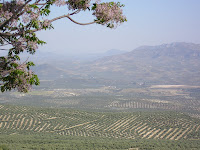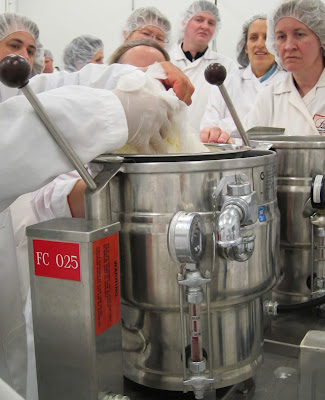Things to Do and See in Baeza and Ubeda, Spain
 The following notes are logistical footnotes which may be helpful to fellow travellers. They accompany earlier blog postings (see below) written when I was in Andalucia. Don’t hesitate to contact me if you would like additional information.
The following notes are logistical footnotes which may be helpful to fellow travellers. They accompany earlier blog postings (see below) written when I was in Andalucia. Don’t hesitate to contact me if you would like additional information.Baeza
I spent 4 nights at the Hotel Fuentenueva (Calle Carmen, 15) in Baeza. It’s an older building that has been renovated with a very modern look, which was fun. The ceiling in my room ascended two stories over the bathroom, and I had a wonderful view from my window over the tiled roofs and churches of Baeza. There is free wifi and an attractive lounge/library if you want a quiet place to sit. The hotel is midway between the downtown core and the bus station, which was very convenient as I took buses to and from various locations every day.
I spent 4 nights at the Hotel Fuentenueva (Calle Carmen, 15) in Baeza. It’s an older building that has been renovated with a very modern look, which was fun. The ceiling in my room ascended two stories over the bathroom, and I had a wonderful view from my window over the tiled roofs and churches of Baeza. There is free wifi and an attractive lounge/library if you want a quiet place to sit. The hotel is midway between the downtown core and the bus station, which was very convenient as I took buses to and from various locations every day.
I had two, excellent meals at Antica Roma, an Italian restaurant (Calle de San Francisco, 39). There was an elaborate décor with Roman statues and frescoes. The pastas were excellent, and there were various vegetarian options. The tiramisu was very good, and the glass of red wine was large.
I particularly enjoyed visiting the art gallery – the Museo A. Moreno (Antiguo Cuartel de Sementales, Calle Tres Fuentes, 2). There are two large, well-laid-out galleries. One showcases the work of local artist, Antonio Moreno, while the other displays travelling exhibits (works by Raquel Bartolome Robledo when I was there). Both exhibits were of good quality and very interesting; it’s a shame I was the only person visiting when I was there.
There are panoramic views of the surrounding countryside from the Paseo de las Murallas/Antonio Machado, even though access from downtown was difficult due to construction. The Paseo can be reached from various points around town – if you reach it from Cuesta de Prieto, you arrive at some seats, and there is a road downhill if you want to w alk among the olive groves and farmyards on the plain.
alk among the olive groves and farmyards on the plain.
 alk among the olive groves and farmyards on the plain.
alk among the olive groves and farmyards on the plain. Ubeda
There are buses almost every hour between Baeza and Ubeda. Ubeda is larger than Baeza and has some wonderful examples of Renaissance architecture.
Don’t miss the Hospital de Santiago or the Capilla del Salvador – they are both outstanding examples of Renaissance architecture. The Plaza de Vasquez de Molina is surrounded by attractive buildings. I recommend visiting the Casa Mudejar (Calle de Cervantes, 6), a 14th-century Jewish home that has been restored and now houses a small archaeological collection. As in Baeza, the walk around the town walls – Redonda de Miradores – is very pleasant.
Additional Blog Postings:




Comments